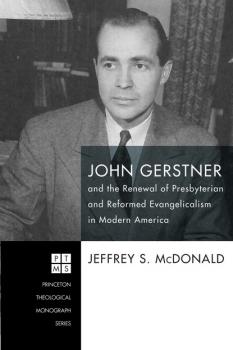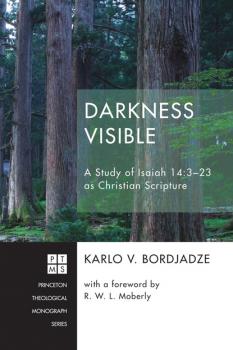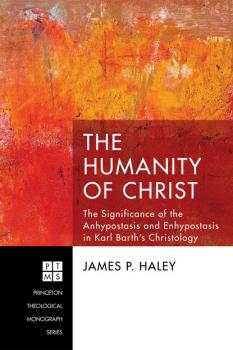Princeton Theological Monograph Series
Скачать книги из серии Princeton Theological Monograph SeriesSimul Sanctification
Why do we see so much fruitful good in unbelievers and so much evil in believers? What could it mean for a believer that the old is «gone,» especially when it doesn't feel that way? What does it mean for humans who are simul iustus et peccator (simultaneously righteous and sinner) to be transformed in Christ and by his Spirit? We typically think of sanctification as pertaining to humans being conformed to Jesus, but what could it mean when Jesus speaks of himself as being sanctified for our sakes (John 17:19)? Jeff McSwain mines the theology of Karl Barth to engage such questions. In looking «through the simul,» he concludes with Barth that universal human transformation is a reality before it is a possibility, and that, despite our contradictory state, we may live Spirit-filled lives as we participate in Christ's true humanity that determines ours–a humanity which never gets old.
Living in the Eighth Day
"I came that you may have life and have it in all its fullness" (John 10:10).
In this book, Revd Dr. Steven Underdown presents the paschal mystery–the passion, death and resurrection of Jesus–as the means by which the Son first realized that utter fullness of life which God had always intended for humankind. He also argues that it is only in and though the paschal mystery that human beings find their fulfillment. Only insofar as someone is open to be given in love is that person open to receive fullness of new life. The book explores some of the ways by which, under God's grace, the church can establish patterns of life and worship which will enable growth into the paschal mystery. It focuses in particular on a weekly pattern of life established in various parish and monastic communities in which every week is celebrated as a kind of «Holy Week in miniature.» This pattern–termed the Pattern of the Week–is seen as providing a context for life-giving response to the divine initiative.
Turning the Tables on Apologetics
Does apologetic method matter? Helmut Thielicke argues that the method should conform to its own message. He thus rejects traditional apologetic methodologies beholden to supposedly neutral scientific and philosophical paradigms. Seeking to reform Christian conversation, Thielicke discovers a lost way of persuasion, that is, the table-turning approach found in Christ's conversations. Whenever Jesus is questioned, he seldom answers directly. For he refuses to allow the conversation to be framed by an autonomous mindset, and instead responds with a counterquestion. Christ's style of persuasion–as the controller of the question–subverts his hearers' presuppositions and challenges their unbelief. This approach is the reverse of the defensive, answer-giving mode of traditional apologetics. In view of renewing Christ's method, Thielicke insists that the task of apologetics is «something which is always on the offensive and, far from giving ready-made answers to the doubtful questions of men, turns the tables by putting questions on its own account–aggressive, violent, radical questions–and striking straight to the hearts of men.» Christian conversation must integrate Christ's method with his message in order to advocate the message itself. For it is not the world that questions Christ, but rather Christ questions the world.
And Still We Wait
In response to the recent critiques made against Balthasar's interpretation of Christ's descent into hell on Holy Saturday, this book argues that Balthasar does not intend to present a radical reinterpretation of the doctrine in contrast to the traditional teachings but rather intends to fully appreciate the in-betweenness of Holy Saturday as the day of transition from the cross to the resurrection, from the old aeon to the new. The book further argues that this awareness of the «in-betweenness» can be detected throughout Balthasar's theological corpus and provides a clue to interpret his thoughts on Christian discipleship and suffering. After all, the Christian existence is also characterized by the transition from the old aeon to the new, from suffering to victory. The Christian believes that their victory is already here and not here yet. In this sense, the Christian still lives in Holy Saturday. Eventually, we can deepen our understanding of Christian discipleship and suffering in the light of Holy Saturday. In short, we could patiently endure our Holy Saturday because of Christ's Holy Saturday in hell.
Excusing Sinners and Blaming God
Calvinist determinism destroys moral responsibility and makes God the author of sin. These two accusations are not new, and were arguably anticipated by Paul in Romans 9, but they remain today the most important objections offered against Calvinist/determinist views of human free will. This book is a philosophically rigorous and comprehensive defense of Calvinism against these two families of arguments. With respect to human moral responsibility, it discusses whether determinism destroys «free will,» turns humans into pets or puppets, and involves or is analogous to coercion and manipulation. It responds to the consequence argument and direct argument for incompatibilism, the principle of alternate possibilities, the «ought implies can» maxim, and related claims. With respect to the authorship of sin, it discusses whether Calvinist determinism improperly involves God in evil. Does it mean that «God sins,» or «causes sin,» or «wills sin» in problematic ways? «Does God intend our sin, or (merely) permit sin?» In each case the coherence of the Calvinist view is defended against its most potent objections, to reject the claim that Calvinism is «excusing sinners and blaming God.»
John Gerstner and the Renewal of Presbyterian and Reformed Evangelicalism in Modern America
John Gerstner (1914-96) was a significant leader in the renewal of Presbyterian and Reformed evangelicalism in America during the second half of the twentieth century. Gerstner's work as a church historian sought to shape evangelicalism, but also northern mainline Presbyterianism. In order to promote evangelical thought he wrote, taught, lectured, debated, and preached widely. In pursuing his aims he promoted the work of the great colonial theologian Jonathan Edwards. He also defended and endorsed biblical inerrancy and the Old Princeton theology. Gerstner was a sharp critic of theological modernism and what he considered its negative influence on the church. Part of Gerstner's fame was his active participation in mainline Presbyterianism and in so many of the smaller Presbyterian denominations and in the wider evangelical movement. His renewal efforts within the United Presbyterian Church USA (later PCUSA) were largely a failure, but they did contribute to the surprising resurgence of Presbyterian and Reformed evangelicalism. Evangelical marginalization in the mainline led Gerstner and other evangelicals to redirect their energy into new evangelical institutions, groups, and denominations. Gerstner's evangelical United Presbyterian Church of North America (UPCNA) background influenced the young scholar and the legacy of the UPCNA's heritage can be detected in the popular forms of the Presbyterian and Reformed evangelical movement that exist today. Moreover, he was significant for the revival of Reformed teaching beyond the bounds of Presbyterianism. This book establishes Gerstner's significance in American church history and provides a thorough analysis of the evangelical movement he sought to reinvigorate.
Darkness Visible
How does one read the Old Testament as Christian Scripture? This question, voiced in both academic and ecclesial settings, invites a reflection on how to take these texts with both hermeneutical alertness and sustained imaginative seriousness. While scholars have recently engaged in robust discussion about theological hermeneutics, there have been relatively few worked examples with particular Old Testament texts. This book seeks to meet this need by providing a close reading of Isaiah 14:3-23, a text with a complex amalgam of textual, historical-critical, history-of-reception, and theological issues.
The Humanity of Christ
This work is a critical analysis of Karl Barth's unique adoption of the concepts anhypostasis and enhypostasis to explain Christ's human nature in union with the Logos, which becomes the ontological foundation that Barth uses to explain Jesus Christ as very God and very man. The significance of these concepts in Barth's Christology first emerges in the Gottingen Dogmatics and is then more fully developed throughout the Church Dogmatics. Barth's unique coupling together of anhypostasis and enhypostasis provides the ontological grounding, flexibility, and precision that so uniquely characterizes his Christology. As such, Barth expresses the Word became flesh as the revelation of God that flows out of the coalescence of Christ's human nature with his divine nature as the mediation of reconciliation. This ontological dynamic provides the impetus for Barth's critique of Chalcedon's static definition of the union of divine and human natures in Christ from which Barth transitions to an active definition of these two natures. Not only does anhypostasis and enhypostasis explain the dynamic union between the divine and human natures in Christ, but also the dynamic union between Jesus Christ and his Church, which reaches its apex in the reconciliation of humanity with God, in Christ. The ontological foundation of anhypostasis and enhypostasis in Christ's union with his Church explains the importance of the royal man in understanding genuine human nature, the exaltation of human nature, and the sanctification of human nature.
Bloodless Atonement?
Does the Messiah have to die to pay for his people's sins? Is the cross of Jesus an atoning sacrifice? In recent decades a burgeoning number of theologians have answered the aforementioned questions in the negative. In fact some, like Rene Girard, have gone so far as to assert that seeing the cross as an atoning sacrifice undermines the very essence of the New Testament Gospels. While Girard and others following in a similar vein have offered provocative alterations to soteriology that no longer need Jesus's death to acquire forgiveness from God, does a bloodless atonement have biblical support? Does a nonviolent understanding of the atonement harmonize with the Gospels? This particular volume answers these questions with a fresh look at the Synoptic portraits of the Last Supper accounts. In them Jesus expounds upon the significance of his death by using the Passover symbols of bread and wine. More importantly, in these passages in the Gospels we find the fullest articulation of how Jesus's death benefits his followers. Holding a wealth of dense theological riches, these passages provide theological parameters that can inform contemporary soteriological development, especially that which appeals to the New Testament for its basis. Conversant with both biblical studies and contemporary theology, the work seeks to bring the best of both fields into conversation in productive new ways.
Martin Luther on Reading the Bible as Christian Scripture
Above all else that the sixteenth-century German Reformer was known for, Martin Luther was a Doctor of the Holy Scriptures. One of the most characteristic features of Luther's approach to Scripture was his resolved christological interpretation of the Bible. Many of the Reformer's interpreters have looked back upon Luther's «Christ-centered» exposition of the Scriptures with sentimentality but have often labeled it as «Christianization,» particularly in regards to Luther's approach of the Old Testament, dismissing his relevance for today's faithful readers of God's Word. This study revisits this assessment of Luther's christological interpretation of Scripture by way of critical analysis of the Reformer's «prefaces to the Bible» that he wrote for his translation of the Scriptures into the German vernacular. This work contends that Luther foremost believes Jesus Christ to be the sensus literalis of Scripture on the basis of the Bible's messianic promise, not enforcing a dogmatic principle onto the scriptural text and its biblical authors that would be otherwise foreign to them. This study asserts that Luther's exegesis of the Bible's «letter» (i.e., his engagement with the biblical text) is primarily responsible for his conviction that Christ is Holy Scripture's literal sense.









